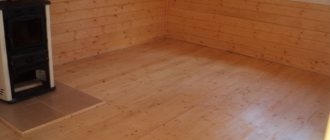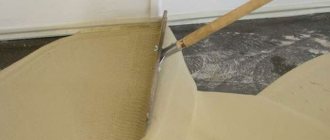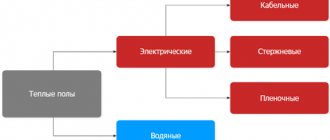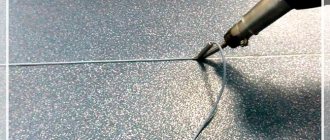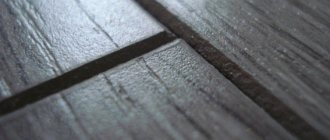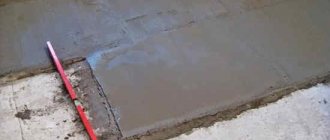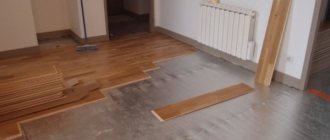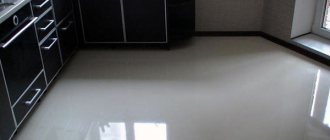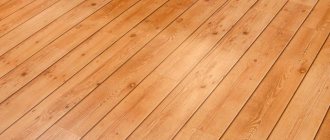Self-leveling floors are one of the most popular technologies today. Due to the ease of installation, this type of coating is most often used for DIY floor installation. The material for their formation is a self-leveling mixture - despite its name, it still requires the presence of a guideline, which most often are pin beacons for self-leveling floors.
The use of a self-leveling mixture implies the solution spreading and leveling on its own over the rough surface, which is not unreasonable - for a relatively small room, this is exactly what happens. However, if a large area is to be filled, you will not be able to form a flat surface without the presence of beacons.
Self-leveling floor: photo
The instructions below on how to place beacons for pouring the floor will help you create a flat surface with your own hands.
Technology of filling the floor using benchmarks
Let's take a closer look at how a self-leveling floor is poured using self-made benchmarks as beacons.
Step 1. First you need to remove the old base, as well as poorly adhering screed elements. This is a foundation preparation process that should not be neglected. Elements that are difficult to remove can be torn off using a hammer drill. The main thing is to remove everything that doesn’t stick well.
The old base is removed
Step 2. Next, you need to thoroughly dust the surface. A construction vacuum cleaner is used for these purposes. Of course, large pieces of mortar and debris must be removed manually.
Next, dust is removed
Step 3. Next, using a laser level or level, you need to evaluate the evenness of the base by finding the highest and lowest points of the floor. Now you can calculate the approximate middle layer - this data will help calculate the optimal mixture consumption.
The floor level is determined
Calculator for calculating dry mortar for self-leveling floors
Step 4. After this, the floors need to be primed. The primer is applied with a brush or roller so that not a single square centimeter is missed. Before further work, the primer layer must be dried.
Applying primer
Step 5. Now you can start making homemade benchmarks. To do this, you will need a small piece of plywood in which you need to drill a hole of small diameter (this will be a template), as well as another piece of plywood and hangers for light suspended ceilings.
A small hole is cut in the plywood
Step 6. Using a plywood template, you need to drill several circles of the same diameter from another piece of plywood.
Using a template, cut out circles of the same diameter
Ready-made circles
Step 7. On each of the round blanks, you need to mark the center with a marker and additionally leave three marks at equal distances from each other along the perimeter of the circle (about 1 cm from the edge).
First, each workpiece is marked with class=”aligncenter” width=”1498″ height=”908″[/img]
Additionally 3 more marks are placed
Step 8. Now you need to remove the metal rods from the ceiling hangers and then take a drill of a slightly smaller diameter than the rods themselves, and use it to drill holes in the wooden circles around the perimeter and in the center of each workpiece.
Holes are drilled in workpieces
Step 9. Next, the benchmarks are assembled. Metal rods from hangers need to be inserted into each circle. The hole in the center should be of such a diameter that the metal rod passes through with force.
Metal rods need to be inserted into the holes
Rods are inserted
Step 10. The outer rods in each workpiece must be installed so that they do not move. This is what the design should look like.
Ready-made homemade benchmarks
Step 11. Next, you need to find the highest point in the room and subtract the minimum acceptable value for the level of the self-leveling floor (for example, 3 mm) from the resulting size. After this, the resulting value must be plotted along the length of the central twig, starting from its bottom.
The central rod is marked
Step 12. The value on one of the bars must be duplicated on the others.
The markings are transferred to the remaining bars
Step 13. Next, you need to place one of the beacons in a place convenient for work and lower the central rod so that the applied mark coincides with the laser beam. Then under the twig you can see the level of thickness of the fill.
Adjusting the first beacon
The mark coincided with the beam
Required fill thickness
Step 14. Then you need to prepare the filling mixture according to the instructions.
Preparing the mixture for filling the floor
Step 15. When the mixture is ready, you can start pouring. The mixture must be poured onto the base in measured doses, guided by the beacons and leveling the mixture with a spatula. As soon as one area is filled and leveled, the lighthouse must be removed immediately. The remaining holes will immediately be filled with the mixture.
Pouring the floor
The mixture is leveled with a spatula
Step 16. During operation, the beacons can be rearranged, adapting them to a new area of the floor.
Beacons can be rearranged
Step 17. After pouring the floor, you need to roll it with a needle roller to remove air bubbles from it. All you have to do is wait for the floors to dry.
The poured floor is rolled with a needle roller
Video - Self-leveling floors using beacons
This is how the self-leveling floor is poured using beacons. Let us repeat that for small rooms there is no need to use them, but in spacious rooms you cannot do without beacons if you want to achieve a perfectly flat floor.
How to find the highest point on the surface of the base?
The normal level breaks through the horizontal. Markers are made on the walls of the room at a suitable height. A noticeable line is drawn along the points. You can use regular dyeing thread for this. Then there is the lowest and highest point of the genital surface. It's easy enough to do.
The normal level breaks through the horizontal
The highest current point can also be located in the central part of the floor of the room. This can be checked just as easily using a paint cord. It is enough to stretch it across the width of the room and view it along the length of the stretch. If a new maximum high place is found, another zero level is drawn. If the area of the detected point is small, it is better to simply remove the protruding area. A hammer drill will be just right here.
In order for the floor to become as level as possible, beacons are necessary for anyone who is involved in leveling work, regardless of whether an experienced master takes up the task or an amateur.
We place beacons
Set to the zero level, they guide the rule and serve as a kind of guideline. Such work may seem tedious and drawn-out, but the final result will depend on the correctness of its implementation.
Installation of beacons
Installation of beacons
Even the most knowledgeable craftsman, in order to obtain a surface without flaws, requires pointers, which are actually guides set at the initial (0) level. By advancing the rule along these peculiar signs, you can level the entire solution to an ideal surface.
It is much more convenient to move the rule according to beacons
Useful tips for placing markers
Do-it-yourself floor screed: how to properly make a cement floor screed
Now that you have made your choice and decided for yourself which beacons are best for screeding your particular floor, you can safely get to work. The first thing I want to tell you is how to place rack beacons under the selected screed. Slat markers are long, even slats that are placed wall to wall throughout the room, parallel to utilities or a long wall. The distance between them is 1–1.7 m.
There are several types of rack markers:
- wooden - modern repairmen practically do not use them. If you nevertheless decide to opt for them, then know: the slats must be removed until the mixture is completely dry, after which the furrows must be sealed with the same composition;
- metal - usually such markers mean a profile for drywall. They are placed at a distance of 1–1.4 m and laid on self-tapping screws, screwed in every 40–50 cm. To set the required height of the metal marks, pull the rope from wall to wall.
Tip #1. The composition should be poured along the markers in stripes. To level the solution, use a rule of 2 spans between the “marks”.
Tip #2. Check the height of the profiles at a variety of angles, not just perpendicular. The result should always be the same - zero horizon. After the beacons are placed, they need to be frozen with a solution.
“Marks” made from steel pipes deserve special attention; they are simply irreplaceable when working with concrete. The technology for their installation is as follows:
- we mark the lines for placing “marks” (the extreme markers should be at a distance of 20–30 cm from the walls);
- every 40–50 cm on the installation lines we make slides with mortar into which we will smear our beacons;
- using a rope and a rule, we set all the “marks” according to the planned level of the new floor;
- We cover each beacon along its entire length with the mixture.
Benchmarks (tripods) are professional markers used in work on leveling planes. In the middle of its structure there is a moving rod that indicates the new height of the coating. The level itself is set according to the caps, on top of this rod.
Tip #3. Under no circumstances leave “marks” in the solution! They must be knocked out, and the resulting furrows must be cleaned, primed and sealed with the same compound.
Friends, now that you know in general terms how to place beacons under a screed, I recommend watching this video.
If the information was useful to you, share it with your friends. Subscribe to our groups on social networks and stay up to date with all construction news. Bye everyone!
Calculation of the number of beacons for a room
It is customary to place beacons in parallel, the beginning of their path is the front door, and their movement leads to the wall opposite. The distance between parallels should be 10 cm or a little more less than the rule itself. The extreme lines are drawn at a distance of 3-4 decimeters from the walls. First you need to calculate where beacon No. 1 will be.
Lighthouses
For example: S (distance) between supposed parallel ones is 6.55 m. The rule is 1.5 m. Reaching the wall, it should be with a margin of 15 cm, which means 1.35 m from the wall. The row next to the first from the edge there will be somewhere S = 1 m, and between the extreme ones there remains 3.85 m. With a maximum S between the beacons of 1.2 meters, there will be 3.85 m: 1.2 m = 3.2 (beacons). It is clear that in this case, in addition to the extreme ones, 2 more will be enough.
(6.55 – 0.7) / 5 = 1.17 m.
0.7 – S from the side beacons to the walls.
5 – number of spaces between beacons.
Fill
Laying tongue and groove floor boards with your own hands
In that bathroom we used the fast-hardening self-leveling floor Osnovit Skorline, because it really hardens almost before our eyes.
We read the information on the bag, pour the volume of water indicated there into the bucket and pour the contents of the bag into it. Stir the whole thing with a mixer until a homogeneous mass without lumps is obtained, the consistency of it resembles batter for pancakes.
After this, the mixture must be allowed to stand for a couple of minutes, during which time the chemical additives in its composition dissolve and begin to act, plus some of the air comes out of the solution.
And then attention: you need to decide on the number of people involved in the pouring process. If the area of the room and the layer are small, you can do it alone
If we have a significant area and/or layer, we will definitely resort to the help of a partner; he will mix the solution for us, and we will pour it and level it. If the layer is completely healthy, a third assistant will not hurt.
Our room is tiny, and the layer is small, so I poured the floor alone. It took only 2.5 bags. The technique is this: pour the solution from a bucket, distributing it over a certain area, maximum 1 sq.m. If half a bucket is enough, put it nearby and roll it over the liqueur with a needle roller, removing any air bubbles remaining in it. Then we stretch it a couple of times using the rule, using zigzag movements to disperse the excess across the surface. If we see that somewhere the solution is not enough, we don’t do anything, we’ll add more later.
At the end you need to stretch it a couple more times, without zigzags. If there is still something left in the bucket, add and repeat the procedure; if not, go mix a new portion
By the way, I draw your attention to the fact that the rule should be kept strictly perpendicular to the floor, so it will not bend and pull more solution than necessary
In addition, there is no need to put pressure on the rule from above; gravity will suffice, otherwise the beacons can be damaged.
Before preparing each subsequent bucket of the mixture, I advise you to clean the walls and bottom if possible, otherwise the solution will build up and build up on them. Here is the result of filling two buckets:
When it is not possible to fill the entire floor of the room, as in our case, we wait until it becomes possible to walk on the filling, and add the solution into the corners and along the walls, relying on the existing plane, and also fill in possible flaws in the already frozen surface.
Tools, materials, accessories
- Bags of mixture
- Aluminum rules 2m or more (the more rules, the better, but two are enough for warming up)
- Spatula (10-15 cm wide)
- Rotary hammer or impact drill
- Mixer attachment
- Hammer (optional)
- Hammer drill
- Bubble level 2m
- Needle roller
- Bucket
- Plastic dowels
- Wood screws (black, rare pitch)
- Screwdriver
- Edge tape (possibly)
- Durable cement plaster or something similar, for example Glims-Vodostop (you only need a little bit, ask your neighbor)
- Acrylic primer
- Wide brush or roller and tray
Here, it seems, everything should be clear, except I’ll say a few words about the edge tape. It is also often called damping (damping - depreciation (English)), since it takes on the linear expansion at the junction of the walls and the floor, which occurs when the solution sets. It is made from polyethylene foam and is sold in any self-respecting hardware store. Not all manufacturers of self-leveling floors require its use, but it is still better to buy it, especially since it costs a penny.
Lighthouses from solution
How to level walls correctly with your own hands Video on how to level walls correctly How to level walls with your own hands using beacons video How to level walls using the rule How to level clay walls What mortar to use to level walls
Lighthouses can also be made from mortar - mortar marks. The advantage of this method over using the same screws is its simplicity and the absence of a negative impact on the base in the form of drilling holes. This is probably why this variation of beacons is used quite often by beginners, despite the fact that it is a point variation.
Photos of installed beacons
The main disadvantage of this method is fragility. Such beacons can easily break/fall off, and this does not require much effort. Moreover, correcting such flaws during the work process is quite difficult.
The essence of the method is simple - piles of mortar are distributed over the floor surface in such a way as to create rows of a certain level of beacons
It is important to understand that the mixture for creating such supports must be identical to or similar to that used to fill the floor
We install beacons on the solution
Base for beacons
Before carrying out any work, the floor should be carefully prepared. Thus, the old coating is completely removed from the surface. Everything should be removed, right down to the rough screed. Next, the surface is assessed. For example, are there strong and deep cracks, how well does the rough screed hold up, are there any deep potholes. If the differences are very large, then it is recommended to eliminate them. It may be necessary to completely dismantle the rough screed, especially if you hear an empty sound when you tap on it.
When preparing the surface, all debris must be carefully removed. For this, it is best to use a construction vacuum cleaner. The surface is carefully primed. The primer can be used to cover the floor surface in two layers. Afterwards waterproofing must be carried out. For this, some use ordinary plastic film. It is also necessary to lay a soundproofing and thermal insulation layer. Further work consists of searching for the zero level.
Beacon installation technology
The oldest method of installing floor beacons was as follows. From wall to wall, bars and slats were packed, which stretched across the entire room. They were either nailed to the walls, or, if the length of the room exceeded their length, they were attached to bars, which served as a support for them and were installed on the ground or subfloor (basic concrete covering, adobe). When pouring, we were guided by the level of these slats, and when the solution dried, these beacons were removed and the resulting recesses at the points of contact were filled with new solution. Nowadays, this method is already outdated. The moment of installing beacons is very important. It determines how smooth the future floor will be. In this case, you cannot do without a laser or hydraulic level. With their help, marks are made on the walls at the expected floor height, then they are connected into a continuous line. In this method, a metal plaster profile is used as beacons. They help in leveling a screed that is not too large, no more than 2-3 cm high. Self-tapping screws should be screwed into the floor and with their help the zero level is marked. A strong thread or fishing line is pulled between the screws to control evenness, and by screwing in and unscrewing the screws, a horizontal position of all threads is achieved. When the zero-level device is completed, tubercles of solution are laid out along the thread or fishing line. They try to make the mixture harden quickly. For this purpose, plaster mixtures are used or alabaster or lime is added to the cement mortar. Plaster profile strips are placed on the tubercles, which are pressed into the tubercles enough to match the stretched threads. Beacons from the plasterboard profile are installed directly on self-tapping screws screwed into the floor at a distance of 40-50 cm from each other, which indicate the zero level of the floor. Focusing on the tensioned thread, the screws are tightened, trying to achieve perfect evenness. After everything is installed, the solution is placed under the profile and covered on both sides. After the solution has dried, the solution begins to be poured between the profiles. Beacons made of steel pipes are installed for large screeds in large rooms. The height of the pipes is adjusted either by pressing into the mortar or by adding mortar. After the pipes are aligned, they are completely covered with mortar. After drying, the pipes are removed and the uneven areas are filled with solution.
Concept
When beacons are used for self-leveling floors, this not only simplifies the work process, but also helps reduce labor during installation. With their help, the thickness of the future floor is determined and its height is set.
But there is one feature here - you must have certain knowledge about beacons, the rules for placing them and the types of construction depending on the situation. In addition to factory-made devices, they can be done independently. You just need to have the appropriate materials and tools at hand. Let us consider in detail the main 8 ways to install beacons under a screed.
Adviсe
On the day of work, it is necessary to provide protection in the room from drafts - in no case should you open windows or speed up the drying of the solution with any heat guns or hair dryers. If the layer of self-leveling floor is thicker than 3 centimeters, then I would recommend watering the hardening surface once an hour with water from a spray bottle or using a brush, otherwise it may crack.
Plus, at the end of the work, it is advisable to cover it with plastic wrap for a day to reduce moisture evaporation. Remember: the thicker the layer, the higher the likelihood of shrinkage cracks.
Since self-leveling floors shrink slightly when they set, it is recommended to cut off the beacons at the end, or simply pull them out if metal ones were used, and then add the mixture into the grooves. If the floor is being prepared for tiles, as in our case, the beacons can be left alone; they will not interfere.
As a rule, tiles can be laid on such a floor already on the third day after pouring, and it is better not to lay floor coverings earlier than after 7 days.
The described method allows everyone to make a self-leveling floor with their own hands. And no worse than an experienced master. Maybe someone can fill the floors without using beacons, but why should you risk it? Do it with them and get great results! I would be glad if you agree to subscribe to updates and receive announcements of new articles by email! Don't worry, no spam, only announcements :-) Good luck with the repair!
Good afternoon It is necessary to level the floor in the room for laying parquet boards. If you put it into the horizon, you will end up with a rather shabby threshold at the entrance to the room, since there are tiles in the corridor and there is no desire to change them. Therefore, the only thing that comes to mind is to install the beacons not horizontally, but so as to bring the future floor level with the corridor. Hence the question: is it possible to level the self-leveling floor along the beacons, but not horizontally? It is clear that all of it will not flow to the bottom point, but will it be able to make a curve on the surface? (The difference is approximately 15 mm per 3 m).
Roman, good afternoon. I am interested in the opinion on the feasibility of completion and the reality of achieving a positive result when performing the planned work). The situation is as follows: a screed with a thickness of 80-100mm has been made across the entire area of the apartment, including the toilet and bathroom rooms, so that the plane of the finishing coating (ceramic tiles with an electric heated floor) for the bathroom and toilet is lower than the plane in the remaining rooms of the apartment. I want to remove part of the screed - approx. 50 mm. Bathroom 2.3x2m, toilet 2.3x1.2m. I plan to use a grinder to cut the existing screed into cells approximately 50x50mm with a depth of approximately 50mm, followed by removal with a hammer drill. If this operation is successful, the surface will be uneven. I'm thinking of pouring a self-leveling floor on top. Is there a possibility that it will adhere normally to this level surface, or is additional processing and leveling of the surface required? Do you have experience performing similar work (removing part of the screed)? or maybe at least a theory.
Yesterday I filled the floor in the bathroom and toilet with vetonitom 3000. I made beacons in the toilet, but I was too lazy in the bathtub and decided to fill it without beacons. In general, I was convinced from my own experience that the author of the site is absolutely right, it is necessary to fill only in the beacons, a small mound has formed in the center of the bathtub, now I will remove it. And in the toilet the floor was level.
Good afternoon Firstly, why do you need to make the bathroom and toilet lower? But if you really want it that way, then the screed can be dismantled. The self-leveling floor doesn’t care whether the base is level or not, you can safely fill it, just prime it well.
Good afternoon Roman, tell me about the beacons, they write here that they put tape on top of the beacon, that is, if after the liqueur shrinks, it will be removed almost flush, or am I mistaken? If without tape the beacon then just need to be cut off as a rule?
Good afternoon. The question is not entirely clear. The adhesive tape is used so that the rule does not get dirty when pressed, and so that it can be removed immediately, and not after the solution has set. Immediately after setting, the tape is removed and pouring is performed. Such beacons still protrude a little later, but it is enough to simply cut them off as a rule when the floor hardens.
https://siteproremont.ru
Floor screed and its varieties
But first, it would be useful to talk about what a screed is, and what types of screeds it comes in? In a general sense, this is a floor layer intermediate between the base and the floor covering. Roughly speaking, it is akin to plaster on the wall. Wall plaster = floor screed. Just to make it clearer.
In a narrow sense, it is understood as a coarse cement-sand mixture lying on the base in a rather thick layer (from 3 cm). This leveling method is used for large differences in height in the room. But it is not always possible and necessary to use such mixtures, so now, in addition to standard cement screeds, building materials manufacturers offer products such as levelers and self-leveling floors.
The pour-on technology is used, as already mentioned, for thin-layer finishing leveling of the surface for laying floor coverings. They, of course, take their name from the method of their application - they are liquid and simply poured onto the subfloor.
Currently, the range of mixtures in this class is huge. They differ in layer thickness, drying time, and strength. In our village, Osnovit and Prospector mixtures are very popular.
Working with pourables is much easier than with a standard screed: they are easier to knead, easier to apply, easier to level, they dry much faster and provide a better-quality coating. And most importantly, it’s almost impossible to mess up with them. It is no secret that the greatest amount of defects in finishing is allowed when installing a screed; it is very rare to see it without cracks and detachment from the base. And yes, this was also on the conscience of old Roman. Well, what can you do, if you don’t spoil it, you won’t learn :-) And although I just wrote that it is almost impossible to repair jambs such as cracks in self-leveling floors, it is quite possible to simply fill them crookedly.
I see this all the time. This is because they write on the packaging that the mixtures are “self-leveling” (try pronouncing that). Here is the usual train of thought of a person: “yeah, this thing is liquid, it will spread into a level on its own.” It would seem that there is logic here, just as there is an inscription on the bag. Now imagine what will happen if you spill a healthy jar of mayonnaise on the floor? Will it spread around the room?
So, this, after all, is not a liquid, it is a mixture. It spreads, but within small limits, forgiving only minor flaws of 1-2 mm.
But don't worry. In this lesson, I will present a self-leveling floor technology that eliminates such anarchy - we will do everything using beacons, and not with ordinary metal ones, but with “rubbed” or “mortar” ones, as they are not called. The bottom line is that the beacons are made from a certain solution, which makes it possible to reduce the minimum layer to literally 1-2 mm (this is as much as the specific mixture for pouring allows), because steel beacons have a thickness of 6 mm; Why do we need the extra expense, right? But more on that later.
It remains to mention the levelers.
This is an intermediate link between a standard CPU screed and a poured floor.
Levelers also have a liquid consistency, but the aggregate in them is coarser. Such things are mainly used for filling deep unevenness and leveling the floor under tiles, where a particularly smooth surface is not needed. By the way, such mixtures are not always called floor levelers; more often they are given names like “thick-layer self-leveling floor”, the essence does not change.
Well, we can finish with the theoretical part, let’s see what we need to set up a pouring machine using mortar beacons.
Laser level for the floor: how to choose the right one
At the preparatory stage, the master asks, among other things, 2 important questions:
- How to measure the required distances?
- How to beat a level.
The quality of the work directly depends on the accuracy of the markings. A number of laser level models have a rangefinder function. Accordingly, with the help of such a device you can solve both of these problems at once. Of course, they will cost more than usual. However, in this case, this is compensated by advanced functionality. Therefore, professionals often prefer to pay more, but at the same time buy a tool with extensive capabilities.
Of course, it is best to take products from well-known manufacturers. However, it is quite possible to save money here. For example, the KACKAD 5MT level, which combines the functions of a laser plumb level and a rangefinder, is one of the best options in terms of the ratio between price and quality. The choice here is quite large, so it is quite possible to choose a model at an affordable price with good functionality.
It should also be noted that to level the floor you need a level capable of setting 2 intersecting planes. It's best if you can do this separately. Also consider the size of the room. Those who engage in such work professionally need a certain range margin. After all, you often have to work on quite large objects. Therefore, be sure to focus on this parameter when choosing a laser level.
An equally important indicator is the level error. We have already noted above that markings should be made with the greatest possible accuracy. Professional levels have an error rate of 0.1 to 0.2 millimeters per 1 meter. This is more than enough for filling floors in relatively small rooms. Household appliances can also be used here. They are, of course, not as accurate as professional ones. But such levels are cheaper. And their error will also be within acceptable limits - from 1 to 4 millimeters per 1 meter. It is best to focus on the average. In particular, for pouring floors, an error of 2 millimeters per 1 meter is a very good option.
If we talk about specific models, then it is worth highlighting X-Line Master 4D, Bosch GLL 2-50, Condtrol XLiner Combo, Condtrol Laser 3D, RED 2D Condtrol, Infiniter CL2, Bosch GLL 2-40. All of them have quite wide functionality. Accordingly, you can use such devices to perform a variety of jobs, including pouring floors. Versatility in this case will only be a plus. Indeed, in the vast majority of cases, repair work is not limited to the floor alone. Well, the best option for precise marking here would be a multifunctional laser level.
And at the end of the article, let's look at how this device is used when pouring a floor. The first thing to do here is markup. To do this, the level is installed in the center of the room, turned on in the horizontal plane and, if necessary, adjusted additionally - some models do everything themselves in automatic mode. As a result, a straight line will appear on the walls. Next, beacons are placed along it, and you can start working. In addition, using a laser level it is possible to check the evenness of the poured screed. This is done very simply. It is necessary to start and set up the device. If there are bumps on the screed, the beam will definitely highlight them. Well, it is recommended to check the surface for the presence of depressions using a strip.
As you can see, working with a laser level is really quite simple. You can master this device very quickly. The most important thing is to learn how to set it correctly before starting work. Yes, a good level sometimes costs several hundred dollars. However, do not forget that for this money you get an accurate multifunctional device that will significantly save time when applying markings. When choosing a level, be sure to consider several indicators. At the same time, think carefully about whether you need all the functionality of the model you like or whether you should buy a simpler and cheaper option. The choice here is really very large. Moreover, it is quite possible to choose an option that suits your financial capabilities and with sufficient functionality - the main thing is to understand why exactly you are buying such a device.
Zero Level Calculation
Now it’s time to determine how thick the floor will be poured. However, the same work is carried out before pouring the screed. To do this you need to use a building level. It is important to determine what height differences there are at the rough foundation. So, you can do this as follows: mark a base point at a height of about 1 m from the floor, then use a laser level, the rays of which are reflected along the entire perimeter of the walls, and, taking measurements from the level line to the base, see what the height difference will be. For example, the maximum value will be 1.01 m, and the minimum will be 0.99 m. This means that the height difference is 2 cm. It is this difference that needs to be eliminated when pouring the self-leveling floor in order to obtain an ideal base. After identifying differences, you need to mark the expected level of the poured floor - this will be the main guideline when installing beacons.
Laser level
It is important to remember that the success of the entire operation largely depends on this stage. So you shouldn’t neglect determining the height difference.
On a note! When the main marking is applied, its points can be connected into a single line for ease of work. You can transfer marking points from a height of 1 m using a tape measure. It is important to take into account the future thickness of the self-leveling floor.
Definition of zero level
Benchmarks for self-leveling floors
It is believed that a self-leveling polymer leveler does not require the preliminary installation of beacons. However, masters do not always rely on his renowned abilities. For control, they use professional devices that provide the ability to maintain horizontal alignment with an accuracy of fractions of a millimeter.
Miniature plastic devices or metal benchmarks with a millimeter scale are attached to the concrete base with self-tapping screws. According to their indications, leveling agent is added or excess is removed with a plate or an angle with a long handle. After filling the leveler, these auxiliary devices are removed.
More about professional beacons
Professional beacon for self-leveling floor
The benchmark is made in the form of a metal tripod with an adjustable vertical pin in the middle. The principle of use is extremely simple: the performer adjusts the central element of the product, setting the desired height of the point located under the reference point and thereby determining the level of the self-leveling floor being installed.
Professional beacons are installed in staggered increments of 100 cm. The base is first treated with a primer. Benchmarks are installed 5-6 hours after this.
Preparing the base for lighthouses
Regardless of how we plan to level the floors in the future, the floor must first be addressed, namely, thorough preparation must be made. To do this you will need to do the following:
- It is mandatory to remove the old covering, for example, if you had linoleum laid, then you will need to remove the baseboards and completely remove the linoleum;
- After removing the coating and assessing the surface, it is necessary to repair all cracks and deep potholes;
- The next step is to thoroughly clean the surface from all kinds of debris and dust, preferably using a specialized construction vacuum cleaner;
- Next, the entire coating is primed;
- After the mandatory installation of a waterproofing layer is carried out, you can use a polyethylene film with a minimum thickness of 0.2 millimeters;
- The next layer is the installation of thermal and sound insulation; these layers are laid according to your own taste and need.
At this point, the preparatory stage of the base for the floor with your own hands can be considered complete. This means you can proceed to the next stage.
What influences the choice
It’s worth saying right away that beacons for self-leveling floors are made from a variety of materials. Among other things, their installation is also carried out differently. Accordingly, the choice of beacons for self-leveling floors is carried out taking into account the physical and mechanical properties of the material that is used directly to level the floor. The thickness of the leveling layer and the skills of the person who will carry out this or that work are also taken into account. There are several groups of beacons, but they are all combined into two:
conclusions
If you know for sure that you can handle pouring the floor yourself, feel free to take on the job. By using special guidelines and self-leveling compounds, you will definitely be able to achieve evenness of the coating. The main thing is to correctly determine the type of equipment and the value of the zero level.
Inexperienced performers who do not know all the intricacies of technology, of course, are better off entrusting the work to professionals. Since the self-leveling coating is very difficult to dismantle, experiments in this matter will definitely be inappropriate. If you doubt your abilities, it is better to call a construction team who will perform a high-quality coating pouring.
Video - Leveling the floor using beacons: instructions from A to Z
- On the rough floor base, lines for beacons are drawn along and across. It is not recommended to place landmarks at a distance closer than 300 mm from the surface of the walls.
Installation of mortar grade beacons
- The composition for the piles must be mixed in the same consistency and composition as the main self-leveling floor. The piles are constructed along the marked line with an indentation of 35-55 cm. The height must be adjusted. They must be higher than the poured floor.
- While the solution has not hardened, take a rule and, by gently pressing on all the piles, simultaneously level it to the level of the self-leveling floor. To ensure correct and even laying of the mortar, a building level is placed on top of the rule. It will guarantee horizontal installation.
Remove all excess from the solution. And the rule is carried over to the next row. After a day, you can start pouring the liquid floor. First coat the surface of the piles with a primer.
The self-leveling floor got its name precisely because of its ability to level under its own weight. “Why does he need beacons?” - you ask.
As practice shows, even a self-leveling mixture must first be evenly distributed over the surface of the base. And the self-leveling effect will only work on a small area of the mixture, that is, if you accidentally drop the solution, it will independently dissolve in the total mass, unlike cement-sand mortars.
Since self-leveling floors begin to dry out quite quickly, when pouring you will not have time to measure the level, whether it has spread enough or whether you need to remove the excess solution a little more. It is for this reason that it is recommended to use beacons.
After installing the beacons, they begin directly to pour the floor, which means that priming the floor, installing waterproofing and other preparatory work for the foundation must be carried out in advance.
Otherwise, such a beacon is also called a benchmark. It is a tripod, with a vertical pin in the center, which runs along the thread and changes its height.
Determine the highest point of the floor, set a benchmark with a central pin at a height of two millimeters at this point. This will be the required height of the self-leveling floor. We wrote in more detail about rappers in this article.
Perhaps it is worthwhile to dwell separately on the method of searching for the highest point of the base.
There are three main ways:
- The easiest, fastest and most accurate way is to use a laser level. It will not only help you quickly determine the highest point of the floor, but will also help you cope with other benchmarks.
- Use a liquid level, which consists of two glass containers connected by a long silicone tube. The system is filled with water so that there is water in the middle of the vessel. This method takes longer and requires at least two people. The accuracy is comparable to a laser level.
- You can use a regular liquid level: the longer it is, the easier it will be to measure. The method is long and has a fairly large percentage of error.
All beacons for self-leveling floors placed around the room are adjusted with the central pin to the same height as the first one. The level will also help you with this task. Thus, you will have a plane along the lower level of the central pin, along which you need to fill the floor.
Advice: The thickness of the layer at a time should not exceed four to five millimeters; violation of this rule may cause destruction of the integrity of the coating.
If some of the benchmarks show a fill height of more than five millimeters, then consider pouring part of the floor the first time and the entire floor the second time.
For example, the benchmark showed a height of nine millimeters at the far wall, and in the middle of the room the height reaches four millimeters.
In this case, you can fill half the room with the first layer.
Draw a line where the benchmarks showed a height of four millimeters, set the benchmark at the edge of the room to five millimeters and start filling, so that the solution does not cross the drawn line.
After the solution has been poured and it is ensured that it is at the required level, the benchmarks are removed so that the self-leveling mixture can fill the places where they are installed. Before pouring the second layer, it is recommended to check the height again over the entire area of the base.
Recommendation: Do not forget to remove the beacons before the solution dries. Otherwise, the remaining holes in the floor may allow water to penetrate into the base. Filling them with a solution after the floor has dried will not be able to create the same wear-resistant properties of the floor as a whole as a solid cast surface.
Horizontal level tapping
The beating is carried out using the following technology:
- a laser level or a plane builder is installed in an area of one room so that its beam hits the walls of adjacent rooms through doorways, a mark is placed on the wall in each room of the house/apartment (it doesn’t matter at what level, the main thing is that it is at the same level) all rooms);
Positioning the plane builder.
- the level is transferred to the center of one of the rooms, the beam is tied to a previously made mark and the distance from the beam to the floor is measured with a tape measure (in the corners and in the center of each wall);
- then the level is transferred to another room, the beam is tied to the previously applied mark, and the distance from the beam to the floor is again measured at each corner of the room and in the center of each wall.
The point of the actions described above is to find the highest point in the apartment/house. Where the distance from the laser beam to the floor is minimal, there is the highest point of the floor. It is from the highest point in the apartment that the finished floor level is measured, based on the requirements for the minimum layer thickness. For cement mortar, the minimum layer is 3 cm, so we add 3 cm to the highest point, this will be the level of our screed. All beacons must be placed at this level.
Example: For simplicity, we will not consider an apartment or a house; we will show an example for one rectangular room. Let's say, based on the results of measurements in the corners of the room, we got: 1st corner - 65.5 cm; The 2nd corner is 66 cm, the 3rd corner is 63 cm, the 4th corner is 62 cm. This means that the highest point is where we have 62 cm. It follows that in order to fill the cement screed you need to pour it to the level of 62-3 = 59 cm from the plane of the laser beam.
Then you need to place the beacons in the found level, i.e. the distance to the beacons is measured precisely from the virtual plane constructed by the level. For convenience, you can make a template from wood or other material on which the required distance is marked; this will allow you not to measure with a tape measure every time. The designs of beacons and methods for adjusting their level will be discussed further.
Advice! For the convenience of measurements, we recommend drawing a plan of the apartment/house on a piece of paper and putting each measurement on this plan, this will be more clear and practical. Alternatively, you can apply the measurement results directly to the walls, next to the measurement site.
Important! The floors of the apartment consist of laid large-format floor slabs, so the highest point most often (in 99%) will be located on one side of the slab, and not in the middle.
When using some modifications of the self-leveling floor, the screed can be brought “to zero” or lowered by a maximum of 5 cm if the lowest point is at the front door and to level the horizontal line you will have to make a step at the entrance to the apartment.
Advice! Instead of a laser device, a hydraulic level can be used; the technology is completely identical to that indicated, but constructions take much longer and are less accurate. If you don’t have a laser level, you can rent one for a very reasonable price.
Wood slats
Filling a floor using wooden beacons is done very rarely today, and dry screeding on them is done more often. This method is now almost never used. The guides are wooden beams (30 mm thick), which must be thoroughly soaked in water before use. After completion of the work, such beacons are pulled out of the set solution, and the resulting voids are filled with fresh mixture. The level is maintained according to the laid screed. To correctly position the beacons, their height is adjusted using wooden wedges, pads, and self-tapping screws.
Today this is the most common method of arranging a not very high screed. Along the line of future placement of the guides, self-tapping screws are screwed into the floor, by screwing in and unscrewing which the height of the profiles is set. To control the horizontal position, a thread, cord or fishing line is pulled between the screwed-in screws.
We suggest you read: Installing beacons on a wall under plaster
The zero level of the future floor is drawn, and tubercles of solution are laid out around the thread. To make the mixture harden faster, alabaster is sometimes poured in. Simply, cement-sand mounds dry out in 2-3 days (the composition with additives sets within 3-4 hours). Quite often the role of beacons is performed by plaster profiles.
Experts recommend fixing the profiles with the same mixture that is used to make the entire screed (without additives, alabaster breaks down quite quickly). It turns out to be much more reliable, but often special plaster compounds are used to attach the guides. Profiles are laid on such tubercles and pressed into the mixture to the required level.
U-shaped profiles for drywall are also used to display beacons. First, self-tapping screws are screwed into the base (the step should be 40-50 cm). Their size is chosen so that at least half fits inside the dowel. Self-tapping screws near the walls are set to the zero level of the future floor (adjustment is made by screwing in or unscrewing).
To make it convenient to install the guides, a thread, cord or wire is stretched between the walls. U-shaped profiles are placed with the base up on top of the screws. The remaining screws are twisted along the stretched thread to align the guides to the zero level of the future floor. The rule checks the correctness of the horizontal, as well as the correct placement of the profiles among themselves. Beacons can be installed in a similar way:
- on wooden blocks;
- bricks;
- tubercles from solution.
After the mixture has set:
- the correctness of the horizontal is checked;
- the beacons are removed and sealed with mortar.
When the mixture is completely dry, screed is poured around the profiles.
